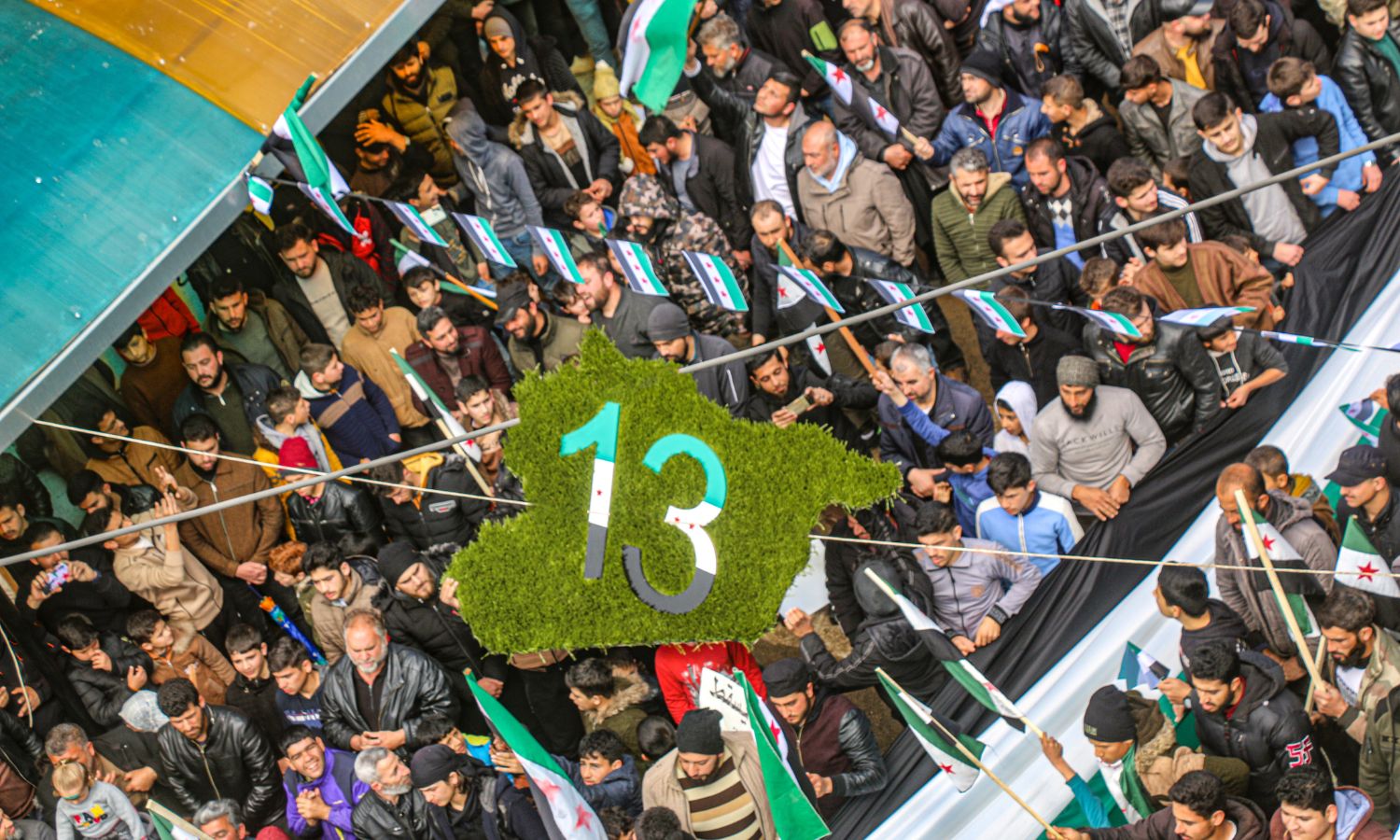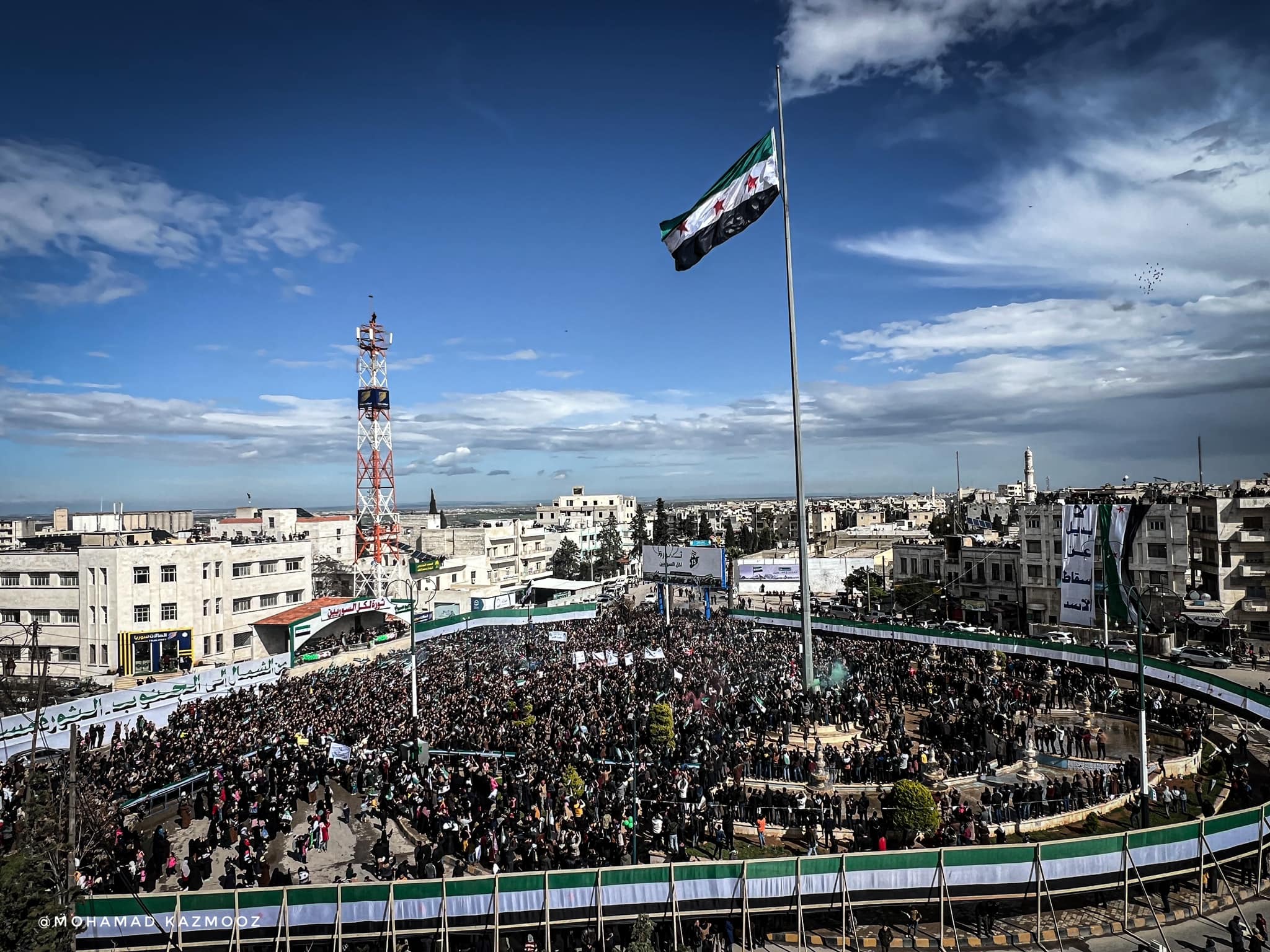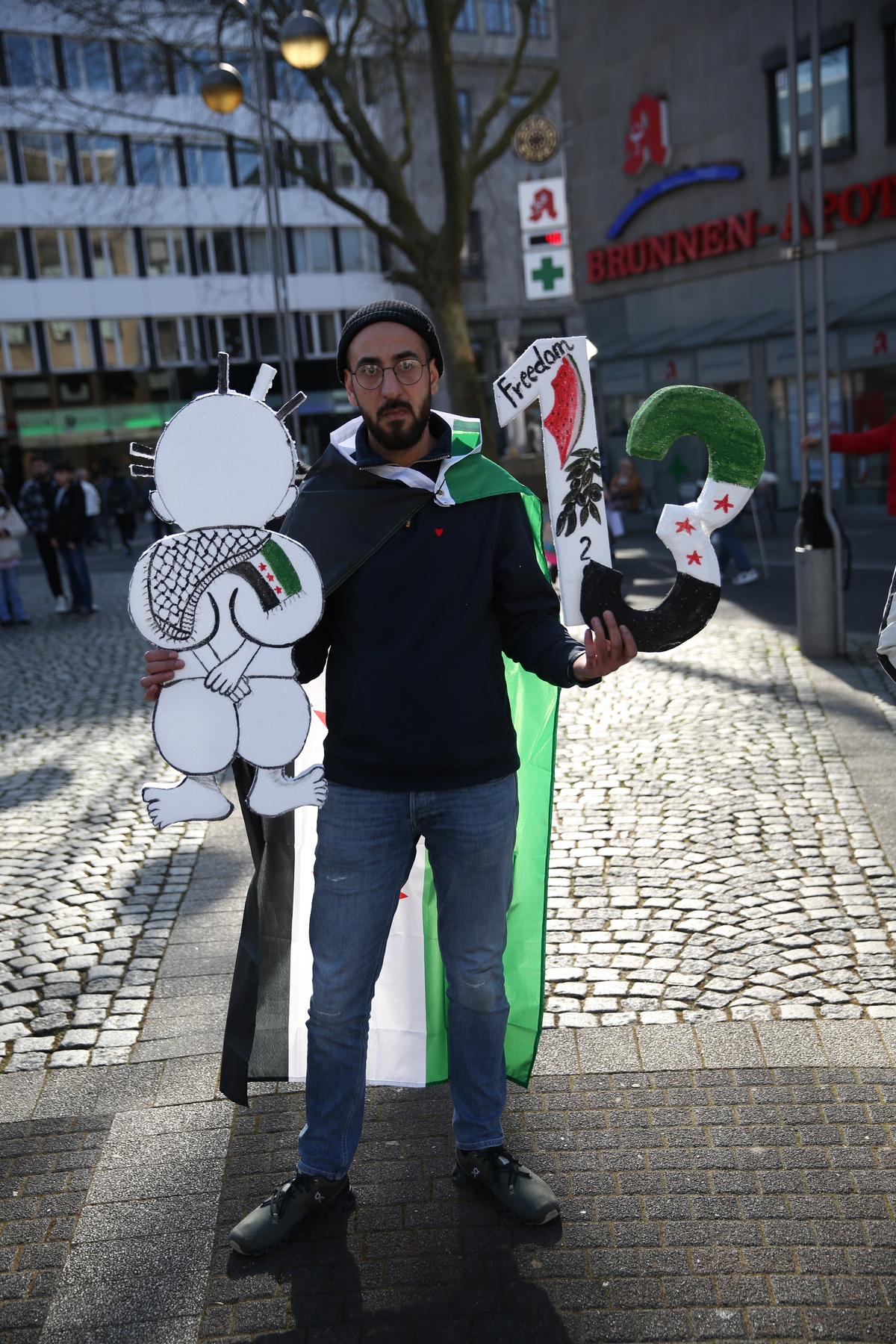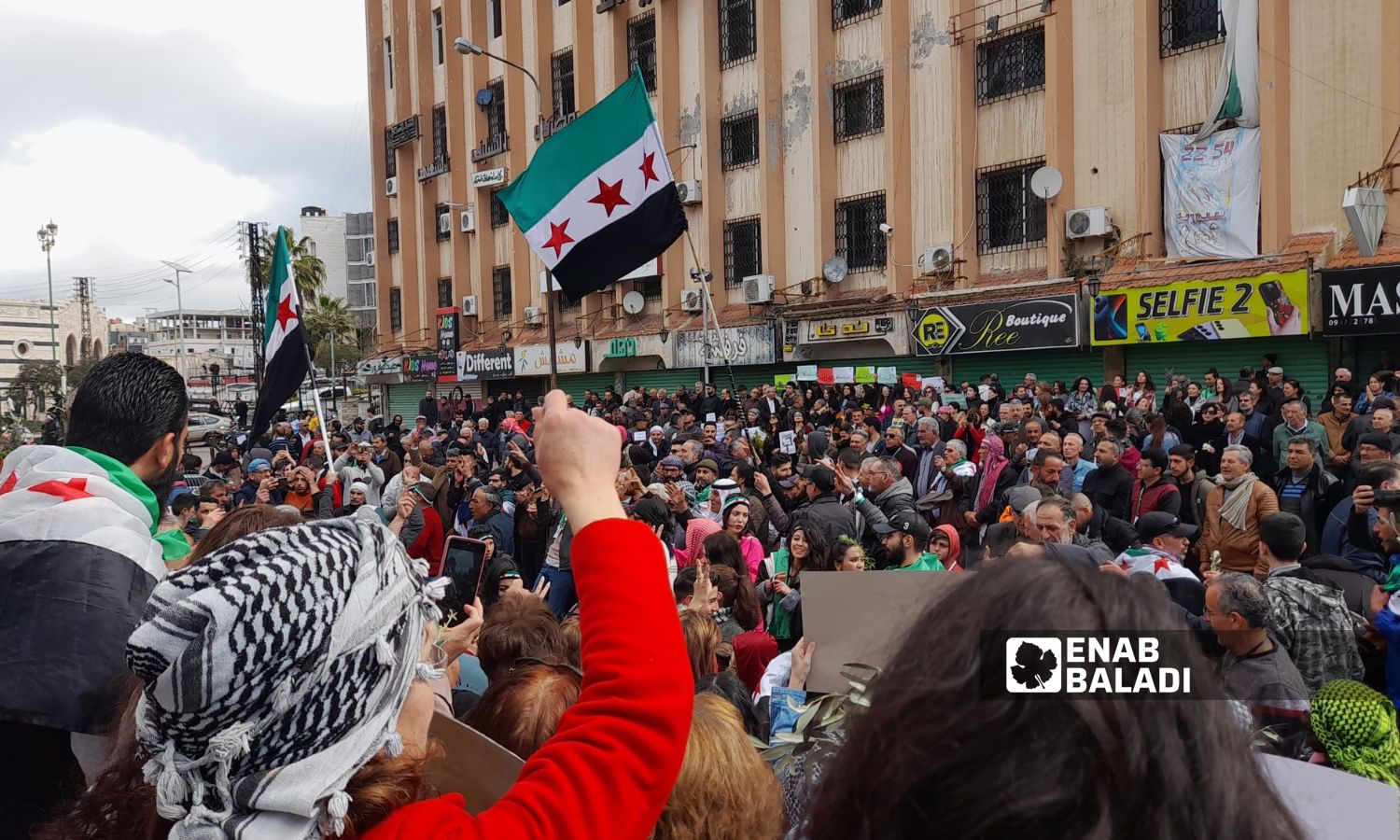


A demonstration to revive the 13th anniversary of the start of the Syrian revolution in the city of Binnish, east of Idlib - March 15, 2024 (Enab Baladi/Iyad Abdul Jawad)


Khaled al-Jeratli | Hassan Ibrahim | Reem Hamoud | Yamen Moghrabi
The disagreement over the starting date of the revolution subsides compared to the discord that has struck Syrian society and the rise of the wall of fear recently rebuilt by the regime, along with the continuation of violations and the commission of war crimes by the de facto authorities, headed by the regime.
For years, some Syrians differed over when and where the first protest in Syria took place, with some preferring to recall the first demonstration that emanated from the al-Hamidiyah market in Damascus on March 15, 2011, while another faction leans towards considering the demonstration that started from the al-Omary mosque in Daraa province on March 18 of the same year, which was shot at and witnessed the fall of the first two civilian martyrs, as the beginning of the popular movement, which apparently is no longer a priority for the majority of the disputants at present, at least.
In more than one direction, Syrians today, with their various political, religious, and ethnic affiliations, live in difficult and complex circumstances. Millions suffer due to the collapse of the economic situation and scarcity of services, and the controlling governments are unable to address and secure needs. The resolution of the Syrian file is linked to the whims of countries supporting various parties within the country.
The difficult security and economic conditions are reflected in the opinions of Syrians during a survey conducted by Enab Baladi in the four control areas, including 47 individuals.
The surveyed segment’s views on the future of the country, the possibility of reaching a political solution, and the return of social cohesion vary, which is discussed in this file with experts and researchers.
The raging war in Syria over 13 years led to radical transformations, some of which were surprising and had a significant impact on the course of events, and produced new de facto authorities controlling and ruling the lives of Syrians.
The Syrian Democratic Forces (SDF) were formed in 2015 from factions formerly labeled “moderate” and others of Kurdish origin, which some Syrians still consider “foreign” today because they represent an ideology launched by the Kurdistan Workers’ Party (PKK) that originated from Turkey many years before.
Today, this military entity manages the lives of Syrians in northeastern Syria under its political umbrella, which has recently added the word “democratic” to its name, becoming the “Democratic Autonomous Administration”. Meanwhile, residents of the region complain of a rift created by the practices of this authority between the components, Arab (majority of the population) and Kurdish (ruler), in addition to the area being turned into a stage for Turkish military operations, where Ankara says it is pursuing Kurdish organizations classified on its terrorism lists.
Adjacent to northeastern Syria towards the west, on the border with Turkey, Hayat Tahrir al-Sham (HTS) governs, which was formed by jihadist organizations. It manages the life aspects of Syrians in Idlib province, parts of western and northern Aleppo countryside, an area from the northern Latakia countryside, and a part of the Hama countryside as well. Its presence deprives the residents of services that could have reached them, due to Tahrir al-Sham being on international terrorism lists, preventing the direction of support to the region.
Recently, protests calling for the departure of the leader of Hayat Tahrir al-Sham, Ahmad al-Shara, known as “Abu Mohammad al-Jolani”, have not stopped, amid his attempts to arrest his opponents and chase threats that shroud his entity built on the ruins of buildings destroyed by military operations over years.
Between northwest and northeast Syria, a factional situation known as the Syrian National Army (SNA) controls the northern countryside of Aleppo and part of the eastern, which its political umbrella, the Syrian Interim Government (SIG), has been trying to organize for years, but its efforts have not reflected on the ground yet.
These factions face accusations of committing violations, some of which are documented with audio and visual evidence, and officials attribute these violations to the newness of the opposition factions, with no experience, and they are working hard to correct mistakes.

Massive crowds gathered in the streets of Idlib to revive the Syrian revolution in its 13th year – March 15, 2024 (Mohamad Kazmooz/Facebook)
Areas under the control of the Syrian regime cannot be seen as one geographical area. While the actual military control is unified in most of it, economic, social, and security contexts vary among them.
While areas under the regime’s control in 2015 were limited to a small geographical area, with parts of Hama, Homs, the Latakia provinces, and a section of the southern provinces, Russian military intervention in Syria disrupted the balance of power, returning control of vast areas of the Syrian map to the regime.
Some areas the regime entered under a “security settlement”, an agreement between the people of several areas and the regime forces mediated by Russia, are still refusing the presence of the regime. This rejection is reflected in targeting operations and assassinations of its elements in their streets.
The southern Syria exemplifies this rejection case, as villages and entire cities have been preventing any military manifestations of the security branches or the Syrian regime’s military forces from entering for more than five years, in addition to daily targeting operations of its elements and soldiers on the roads connecting the villages and cities.
This condition can be projected onto most areas controlled by the regime after 2015, by virtue of “settlement” agreements in which Russia played the role of mediator, then later abandoned them.
Parallel to the state of division and the absence of security, the economic situation continues to deteriorate under the pressure of Western sanctions and the inability of the regime and Russia to recover the geographically resource-rich areas, being under American influence in eastern Syria, in addition to poor economic management and lack of resources outside the regime’s areas of influence.
Syrians in the four control areas live under similar, deteriorating living conditions, and conflict and division heighten the state of economic separation with the devaluation of the Syrian pound and its weak circulation. In northwest Syria, residents trade the Turkish lira and the US dollar at times, using them instead of the local Syrian currency.
While northeastern Syria maintained its economy linked to the Central Bank in Damascus, the Autonomous Administration of North and East Syria (AANES) managed to secure better salaries for its regional employees than those offered by the regime. While an Autonomous Administration government employee’s salary reaches over one million Syrian pounds, it does not exceed 250,000 pounds with the regime.
The economic situation in Syria continues to deteriorate year after year. The regime’s government policies lead to ongoing financial inflation and record figures in economic collapse indicators such as the value of the pound and the prices of gold and fuel annually.
The value of the Syrian pound against the US dollar decreased by 113% on an annual basis during the year 2023, and by 180% on the level of official bulletins issued by the Central Bank of Syria (CBS).
In 2023, the Syrian pound recorded its lowest value against the dollar on August 16, reaching 15,500 pounds, one day after an announced increase in the monthly salary by 100% in Syrian pounds.
The exchange rate of the Syrian pound against the dollar at the time of this report’s release is 13,850 according to the S-P Today website, which specializes in monitoring currency movements in Syria.
As for gold, the sale price of a gram of 21-karat increased to 812,000 Syrian pounds in December 2023, while at the beginning of this year, it was, according to the Damascus Craft Association for Jewelry and Jewelry Making, 325,000 pounds, an increase of about 150%.
Fuel prices soared to record numbers during 2023, including both subsidized and unsubsidized fuels, amid government rationing in selling these materials and a significant decrease in the purchasing power of the population.
The increase in the price of a liter of subsidized gasoline during the current year reached 200%, and in the free market 226%. As for diesel, the increase for subsidized diesel reached 185%, and for unsubsidized 159%.
The state’s general budget is also one of the main indicators of the local economic condition. This indicator is declining after the 2024 budget was the lowest value since 2011, amounting to 35,550 billion Syrian pounds, while the total deficit in the budget was 9,404 billion pounds. Based on the Central Bank’s exchange rate at its issuance (12,600 pounds), it equals about 2.82 billion dollars, a reduction in value of about 2.66 billion dollars, and by 48% compared to last year’s budget.
Opinions varied among Syrians surveyed by Enab Baladi in different areas of control, and in response to the question, “Do you think the Syrian revolution is ongoing?” 25 out of 42 people surveyed (+59%) believe that the revolution is still ongoing.
16 people (+38%) included in the survey believed that the Syrian revolution had ended years ago.
And one person responded neutrally (I don’t know).
The political, economic, security, and even social reality has affected the opinions of the targeted segments in the survey regarding the reasons behind this, as some of them saw that the revolution is not ongoing because it has deviated from its course and became hostage to foreign states.
While those carrying the basic demands have left the country, or sat in their homes, withdrawing from activity.
A segment of Syrians sees the future of Syria as a region filled with killing, hunger, theft, rape, and the spread of drugs.
The current division of control areas in Syria reflected in the survey conducted by Enab Baladi, as the largest segment clung to the goals of the revolution, while the opinions surveyed in the areas that came under the control of the Syrian regime in the past years in Damascus and Daraa showed a state of frustration, and As-Suwayda maintained the momentum of its movement against the regime, which is still ongoing, as the respondents from this governorate expressed optimism about the departure of the regime and the building of a civil state in the future.
A high percentage of Syrians surveyed in different areas of control expressed pessimism about the future of the country, and when answering the question, “How do you see the future of Syria?” 15 people said that they see it going for the worse, and 16 said they do not know, while 16 people (+34%) expressed optimism about the future.
The answers indicate that about 65% of Syrians are either not optimistic or do not have an idea about the future of Syria.
Enab Baladi asked experts about the possibility of change at the top of the regime and its effects, as the senior fellow at the Omran Center for Strategic Studies, Danny Baaj, thinks that the departure of the Syrian regime’s president, Bashar al-Assad, from power “is a minor detail of little importance,” as change is linked to Syria’s regional role, not Assad’s role in power.
In his talk to Enab Baladi, he said that Syria historically has been a regional player, and after the revolution, it turned into a “negotiation card,” as a result of al-Assad allowing blatant Iranian intervention in the country, which formed the features of a “struggle over Syria,” and made Syria’s previous regional role completely hostage to Iran, which indicates that the problem is no longer Bashar al-Assad, but is bigger than that.
Based on the reality described by Baaj, the researcher believes that the political settlement that might be reached by international parties active in the Syrian file will determine what happens in the future, and if the parties agree on Assad’s departure, he will leave, and vice versa.
Baaj views the scenario of Assad’s departure as the least likely in terms of implementation chances, not for the possibility of reaching this outcome. The reason, according to Baaj, is that the regime plays a role in internal balance, and as long as the opposition remains in place and has not played a role in this context, there will be no chance of imposing a new scenario leading to Assad’s departure.
On the other hand, the director of the information department and researcher at the Jusoor Center for Studies, Wael Alwan, looks at the current situation in Syria as bigger than the person of Bashar al-Assad, although the latter bears responsibility for everything that happened over the past 13 years, considering that changing al-Assad will not solve the problems of Syrians today.
Alwan told Enab Baladi that the solution lies in changing the entire regime, pointing out that thousands of officers working under the regime’s dome are actually involved in the blood of Syrians, and the opposition will not reach a result by sidelining Bashar al-Assad and keeping these.
Alwan considered that the Russian military intervention in the Syrian file in 2015 internationalized the Syrian case and closely linked it to foreign international understandings and interests.
Based on the foregoing, Alwan believes that Bashar al-Assad’s departure from power is a main part of the solution, but it is not the complete solution.

From a demonstration in the city of Bochum, Germany on the 13th anniversary of the Syrian revolution – March 9, 2024 (Abdul Moeen Homs\Enab Baladi)
The Syrian opposition politician, Yahya al-Aridi, told Enab Baladi that if the search is for a radical solution to the Syrian issue, it must be seen that the departure of the Syrian regime is more than a necessity.
On the other hand, if the solutions are “patchwork” or temporary, the solution can be interpreted to lead to something else.
Al-Aridi believes that Syria today is divided under the control of de facto authorities, which have committed some violations in turn, but they do not equal a tenth of what the Syrian regime has committed against Syrians.
He added that the de facto authorities have controlled areas for years, but this control entirely depends on the presence of other international or regional powers by their side, as the United States supports the SDF in northeast Syria, Turkey supports the Syrian National Army north of Aleppo, and Tahrir al-Sham benefits from this support in Idlib.
Iran and Russia stand by the Syrian regime forces in central and southern Syria.
Looking at the reality of the spread of these authorities, al-Aridi sees that their legitimacy is entirely derived from foreign powers, and there is no party among them that derives its actual legitimacy from the Syrian people.
The political researcher at the Omran Center, Ammar Kahf, attributed the Syrians’ optimism about the existence of a near solution, to the state of suffering and displacement they have experienced over the past years, which increased their determination to adhere to their demands.
At the same time, Kahf excluded any political solution or real settlement during at least the next two years.
He added that the entire region is experiencing “new birth pangs entitled the restoration of stability in the region,” and so far, no specific definition of this stability has been shown by the regional actors, and therefore it is impossible to read reflections of these changes for each country separately, including Syria.
The researcher added that no situation of stability could include al-Assad, especially since the Syrian regime does not possess the tools of stability itself and does not play its role according to the regional game and the rules of crisis management in the region.
Kahf pointed out that the Syrian regime is still resisting any solution that might impose stability in the region, which caused all attempts of normalization with it to fail completely, placing it in an “unknown fate” within the development of events.
Kahf expected that no solution or settlement looms on the horizon, but the parties active in the Syrian file are trying to “fragment the conflict” and turn it into small conflicts here and there, and drone attacks, and military operations by all parties.
At the same time, Kahf believes that the situation of freezing or fragmenting the conflict in Syria is still fragile, but the serious repercussions of freezing or fragmenting the conflict are the state of division in the Syrian society towards small communities with multiple governance patterns, educational models, and currencies used, which is a danger to the future of Syria as one state.
The statement posed by the Syrian regime president, Bashar Al-Assad, in his speech in front of the members of the Syrian People’s Assembly in 2017, has always been a subject of ridicule by those opposed to him, as he said that Syria had lost its finest youth but had gained a “homogeneous society in the literal sense, not in terms of compliments.”
The past 13 years have revealed what could be described as a rift between the components of society, which led international entities and governments to describe what is happening in Syria as a “conflict” or “civil war,” instead of “the Syrian revolution” adopted by millions of Syrians and circulated by many media outlets.
Enab Baladi posed a question in its survey, asking whether participants believe that Syrian society is like-minded, and the answers varied depending on the distribution of the sample queried in the four control areas, but they expressed the depth of the crisis at the social level.
More than 57% of Syrians surveyed believe that the Syrian people today are dissimilar, and the remaining percentage was divided between considering it similar or answering “I don’t know.”
The figures reflect the impact of the conflict on the social structure and perhaps indicate the absence of a unifying national identity in Syria.
To explain the opinions of Syrians regarding the coherence of society or lack thereof, Enab Baladi asked Dr. Hossam al-Saad, a sociologist, to explain that the concept of homogeneity refers to the existence of social groups that match in religion, social and familial systems, values, and beliefs, which serve as a bond for them and guide their behavior and actions, resulting in similar patterns of personalities and ideas, but they may differ in the concept of harmony which means the existence of different thought patterns and personalities but characterized by acceptance, appreciation of difference, which is a feature of modern societies in general.
Regarding the differing opinions of Syrians as to whether their society is coherent, al-Saad sees the division around any idea or current situation as a healthy state, based on each personality’s reading of the meaning of division from its perspective, following the background and ideology, religion, nationalism, or humanity.
Despite the division in the social body caused by the Syrian war, al-Saad believes that many wish to see the division as a temporary condition, but in reality, it goes back to the individual’s position in society, and the value of society to them.
Most of the cases covered by the survey saw that Syrians are not similar, but Dr. al-Saad believes that Syrian society is highly similar in terms of personal structure, as its members without exception have suffered from the consequences of the war, each according to the pattern of his suffering and the party from which he suffered.
In the future, it is possible to rely on reestablishing social cohesion again, and this is conditional on a democratic political transformation that includes all components of Syrian society, according to al-Saad, who believes that what “the repressive ideology” separated can be rectified by political democracy.
As-Suwayda province was a present example in the sample surveyed in northwest Syria, and even in the far east of Syria, Deir Ezzor province, indicating an ongoing connection at the level of concerns between social categories.
Abdul Karim Muhammad, an employee of a charity in the town of al-Baghouz, east of Deir Ezzor governorate, believes that the Syrian people are still homogeneous, and the biggest proof is the protests of As-Suwayda, a view shared with activist Majid Abdul Noor, residing in northwest Syria, citing the state of sympathy shown by the Syrian society after the earthquake on February 6, 2023, which struck northern Syria.
While those opposing the Syrian regime look at the As-Suwayda movement as evidence of similarity, Ghosoun, 42, from Latakia province, sees that Syrians of different orientations and beliefs resemble each other in the state of poverty, concerns about securing food, and dreams of visiting the market.
Dr. Hossam al-Saad, a sociologist, looks at the return of homogeneity between members of Syrian society as possible to implement if it includes the political side, i.e., the existence of rational political forces that consider the interests of all components of the Syrian people, or the economic situation such as reconstruction, opening a job market, etc., which is attractive for social cohesion because of the intersection of interests by community factions.
Everything mentioned above indicates the need for Syria to urgently solve the political problem, which is not possible from the perspective of political analysts, and rebuilding the state requires many years, meaning that the lack of solutions and the horizon blocked by barriers to division and the continuation of the regime’s repressive authority, and failure to respond to international resolutions and people’s demands for change and political transition, will all affect the lives of Syrians, as well as push them towards pessimism about the future of their country, and compel them to migrate at any cost, which are options expressed by individuals in Enab Baladi‘s survey.

Peaceful protests in As-Suwayda on the 13th anniversary of the start of the Syrian revolution – March 15, 2024 (Enab Baladi)
if you think the article contain wrong information or you have additional details Send Correction